Kipling Before Mowgli
This December marks the sesquicentennial of one of the English language's most prolific, quoted, adapted, and problematic authors: Rudyard Kipling. Born in 1865 in the city we now call Mumbai, Kipling was a master wordsmith, a keen observer of human nature, and the major voice, 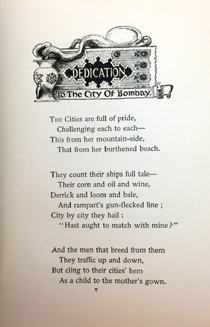 for good and ill, of the late-stage British Empire.
for good and ill, of the late-stage British Empire.
In an era when many readers strive to decolonize their brains and bookshelves, Kipling is troublesome, yet resonant: at least ten films have been based on his life and work in the past decade alone. And there's no question that he was and is widely read at the New York Society Library. We began acquiring Kipling early and hold a number of notable or beautiful editions. Here's a picturesque stroll through the first phase of his career. Click on an image for a larger version.
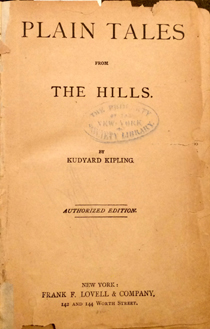 I'm guessing that Kipling was not so famous when this cheap American edition (left) was published: his name is egregiously misspelled on its title page!
I'm guessing that Kipling was not so famous when this cheap American edition (left) was published: his name is egregiously misspelled on its title page! 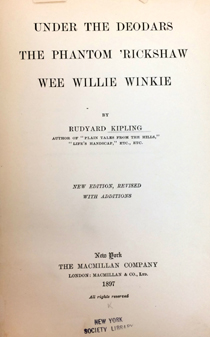
This 1897 Macmillan edition (right) combines three short collections originally published in 1888 and comprising some even earlier materials. Two of the Phantom 'Rickshaw stories originally appeared in an 1885 periodical; here they join an earlier magazine story and an entirely new piece - The Man Who Would Be King, source of John Huston's ripping 1975 epic.
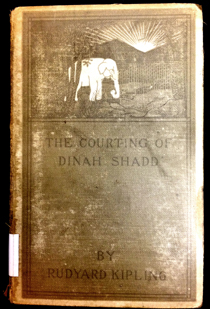 This short work (left) dates from 1890; our edition is Doubleday's of nine years later, but it features a noble cover elephant.
This short work (left) dates from 1890; our edition is Doubleday's of nine years later, but it features a noble cover elephant.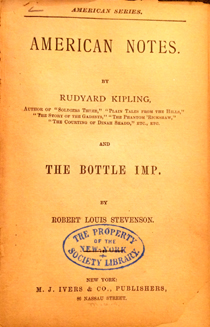
In 1889, Kipling traveled across the United States from west to east, sending weekly reports to his Allahabad newspaper. These were collected in American Notes (right), the earliest Kipling book for which we hold a first edition. It's combined here with a lesser-known work by another classic talespinner, Robert Louis Stevenson.
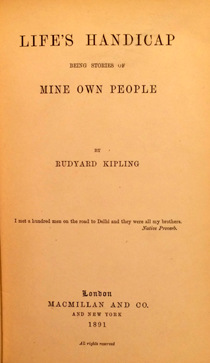 Life's Handicap (left) was published in response to a pirated New York edition of some of its stories. I love the epigraph: "I met a hundred men on the road to Delhi and they were all my brothers." - Native Proverb
Life's Handicap (left) was published in response to a pirated New York edition of some of its stories. I love the epigraph: "I met a hundred men on the road to Delhi and they were all my brothers." - Native Proverb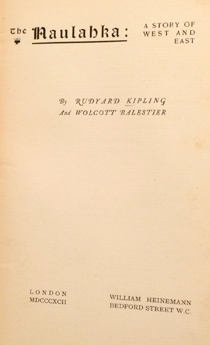
Evocative typesetting in this first edition of an unusual book (right). Kipling serialized this project with author Wolcott Balestier, who died suddenly after two installments, leaving Kipling to complete the story for book publication. The Naulahka is set in the American Wild West, with characters and plot elements from India.
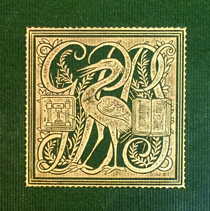 The Library also holds a lovely 1897 Macmillan edition which, like several Kipling printings, includes this striking cover device.
The Library also holds a lovely 1897 Macmillan edition which, like several Kipling printings, includes this striking cover device.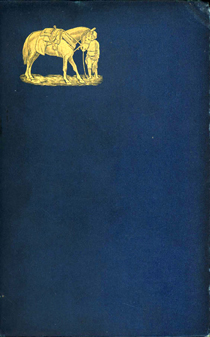
The original 1892 publication of Barrack-Room Ballads (right) introduced the world to Gunga Din and the road to Mandalay.
In 1894, Kipling joined the immortals with the first publication of The Jungle Book. Library records suggest that we once held an early printing of the exploits of Mowgli, Toomai of the Elephants, and Rikki-Tikki-Tavi. It may have been loved to pieces by our readers. Plenty of later editions remain in both the children's and adult collections, however.
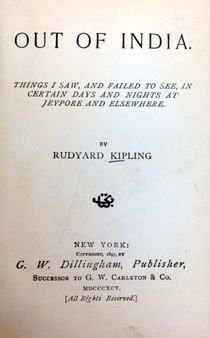 Immortality brought its problems. This 1895 volume (left) combines previously published materials with a scrapbook of India impressions. Our catalog mentions a note from the Critic magazine: "Mr. Kipling denies authorship and says that the work is made up of...newspaper articles and interpolations."
Immortality brought its problems. This 1895 volume (left) combines previously published materials with a scrapbook of India impressions. Our catalog mentions a note from the Critic magazine: "Mr. Kipling denies authorship and says that the work is made up of...newspaper articles and interpolations."
A postscript: One of my favorite Kipling-inspired artifacts is this catchy and whimsical 1970 song by the folk-rocker Donovan. It's a scrap of Scots/English autobiography, with a reggae beat, about an Indian mongoose. What could better complement Kipling's oh-so-British yet international scope?
Thanks to Erin Schreiner for her help with this article.
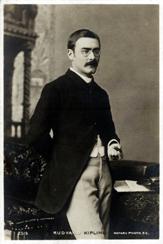

Disqus Comments